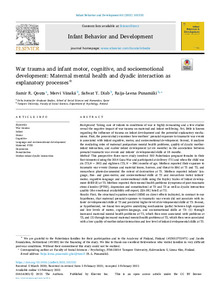War trauma and infant motor, cognitive, and socioemotional development : Maternal mental health and dyadic interaction as explanatory processes
Qouta, Samir R.; Vänskä, Mervi; Diab, Safwat Y.; Punamäki, Raija Leena (2021-05)
Qouta, Samir R.
Vänskä, Mervi
Diab, Safwat Y.
Punamäki, Raija Leena
05 / 2021
101532
Julkaisun pysyvä osoite on
https://urn.fi/URN:NBN:fi:tuni-202106215990
https://urn.fi/URN:NBN:fi:tuni-202106215990
Kuvaus
Peer reviewed
Tiivistelmä
Background: Taking care of infants in conditions of war is highly demanding and a few studies reveal the negative impact of war trauma on maternal and infant well-being. Yet, little is known regarding the influence of trauma on infant development and the potential explanatory mechanisms. First, the present study examines how mothers’ prenatal exposure to traumatic war events is associated with infant cognitive, motor, and socioemotional development. Second, it analyses the mediating roles of maternal postpartum mental health problems, quality of dyadic mother-infant interaction, and earlier infant development (at six months) in the association between prenatal traumatic war events and infants’ developmental skills at 18 months. Method: This prospective three-wave study involved 502 Palestinian pregnant females in their first trimester during the 2014 Gaza War and participated at delivery (T1) and when the child was six (T2;N = 392) and eighteen (T3; N = 386) months of age. Mothers reported their exposure to traumatic war events (human and material losses, horrors, and threat to life) at T1 and T2, and researchers photo-documented the extent of destruction at T1. Mothers reported infants’ language, fine- and gross-motor, and socioemotional skills at T2 and researchers tested infants’ motor, cognitive-language and socioemotional skills using the Bayley Scales of Infant development (BSID-II) at T3. Mothers reported their mental health problems (symptoms of post-traumatic stress disorder [PTSD], depression and somatization) at T2 and T3 as well as dyadic interaction quality (the emotional availability self-report, [EA-SR] brief) at T2. Results: First, the structural equation model (SEM) on direct effects indicated, in contrast to our hypotheses, that maternal prenatal exposure to traumatic war events did not associate with infants’ developmental skills at T2 and predicted higher level of developmental skills at T3. Second, as hypothesized, we found two negative underlying mechanisms (paths) between high exposure and low levels of motor, cognitive-language, and socioemotional skills at T3: (1) through increased maternal mental health problems at T2, which then were associated with problems at T3, and (2) through increased maternal mental health problems at T2, which then were associated with a low quality of mother-infant-interaction and low level of infant developmental skills at T2. Conclusion: Improving maternal mental health and encouraging close and positive dyadic interaction can be critical for infant sensorimotor, cognitive, and socioemotional development in war conditions.
Kokoelmat
- TUNICRIS-julkaisut [16908]
